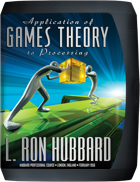
GAMES CONGRESS
What is life? From holiest of temples to everyday streets, it is a question long asked, but never answered. In this Congress, L. Ron Hubbard presents the surprising resolution—all stemming from his groundbreaking research into a subject deceptively irrelevant at first glance, but factually embracing the whole of existence— Life is a game! For notwithstanding the slings and arrows of life, the reason for living and the reason for a game are the same. And whether baseball, polo or chess—by studying the elements of games, we find ourselves in possession of the elements of life. Here, then, are the components: freedom, barriers and purposes, and the exact factors determining a “game” and a “no-game condition.” He further details the four types of games—including those the being doesn’t know he’s playing—the basis of all aberration. Through lecture after lecture Mr. Hubbard lays out the application of games principles to all life—from individuals, groups and societies to revelations on why a thetan loves problems and, hence, the approach in auditing to not only improve one’s ability to play the game, but to achieve truth itself. So groundbreaking were these discoveries, they also formed the very core of what else L. Ron Hubbard released at this Congress: Scientology: The Fundamentals of Thought—a book he forevermore called, “Book One of Scientology.”
Read MoreMORE ABOUT GAMES CONGRESS
There could be a thousand reasons why life is being lived. There could be a thousand patterns on which life is being constantly redesigned. But the one which delivers to us the best results, the one which stands the test, is Games Theory. And none of the others do. —L. Ron Hubbard
What is life? A simple enough question. Yet in 1956, through the course of his relentless research, L. Ron Hubbard spoke of filling page after page with possible answers…until he had listed some five hundred potential patterns of life. And only one, the least likely of all, proved out. Thus, the conclusion—deceptive in that it seemed irrelevant, yet altogether surprising in that it was completely pervasive: Life is a game.
And with that news spreading through the Scientology world, with a promise of even more, it was no surprise when the Games Congress drew the largest gathering of Scientologists to date. It commenced on a holiday weekend of August 31, 1956. And while Washington DC’s Shoreham Hotel had previously seen a Scientology Congress, this one was different—requiring the vast and ornate Main Ballroom to accommodate the more than 400 attendees. And that’s not counting the six-foot “Mama and Papa” dummies with which Mr. Hubbard demonstrated Group Processing between his first description and dissection of Games.
Soon the elements and rules of that game took shape: freedom, barriers, purposes—applicable to any game; The conditions defining a “game,” among them: identity, opponents, motion and emotion; Those which define a “no-game,” including: solutions, serenity and no-motion; The elements of “control”—start, change and stop; The role an individual plays in a game—self-determined or pan-determined; And even the factor of knowingly or unknowingly playing a game.
But regardless of what, where and how one played, the basic rules were always the same and they explained the shape of life itself.
And therein lay the essence of what else L. Ron Hubbard was to present: The first edition of Scientology: The Fundamentals of Thought, the book he would forevermore refer to as “Book One of Scientology.”
Here, then, are the watershed lectures on the underlying reason why every earlier quest for answers failed, the discovery of why a thetan loves problems and, in turn, a brand-new approach to auditing not only to improve one’s ability to play the game, but to achieve truth itself.



